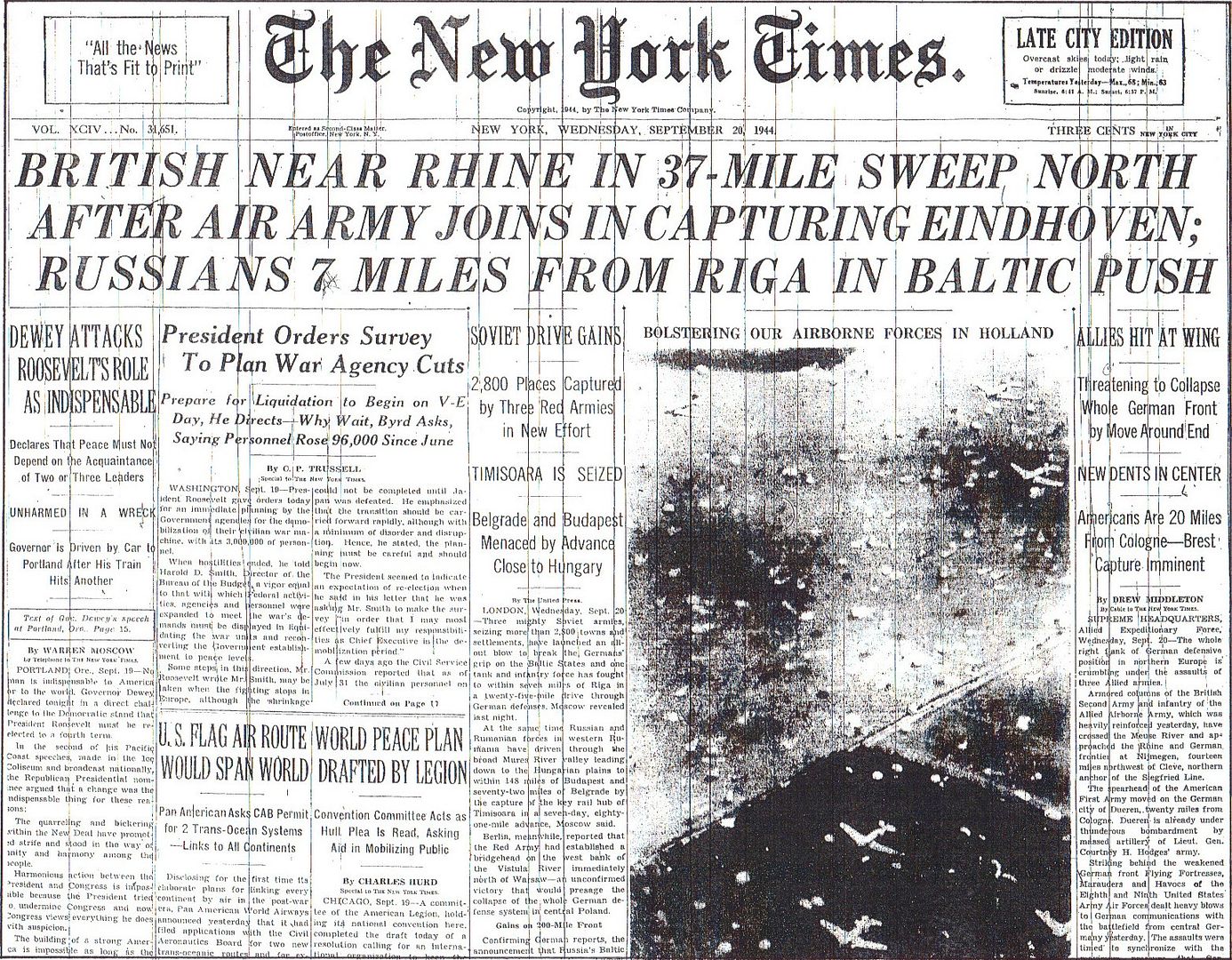
Posted on 09/20/2014 4:17:35 AM PDT by Homer_J_Simpson

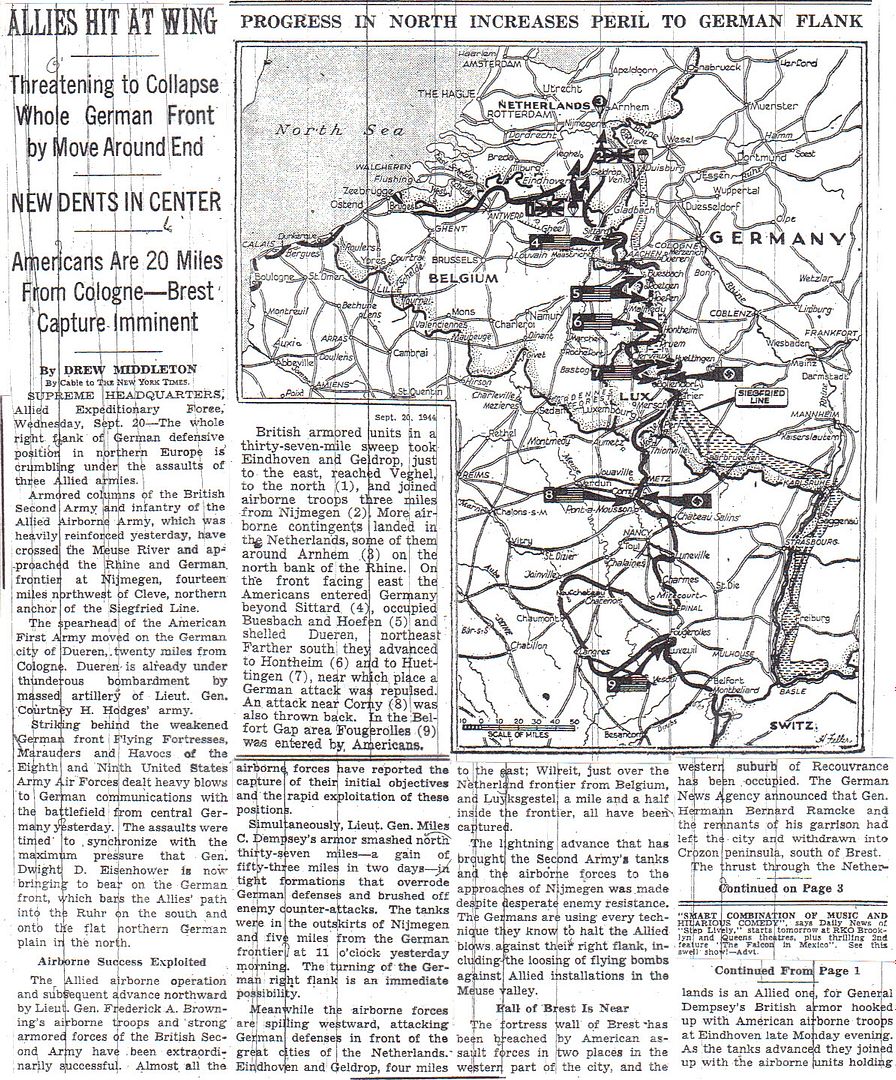
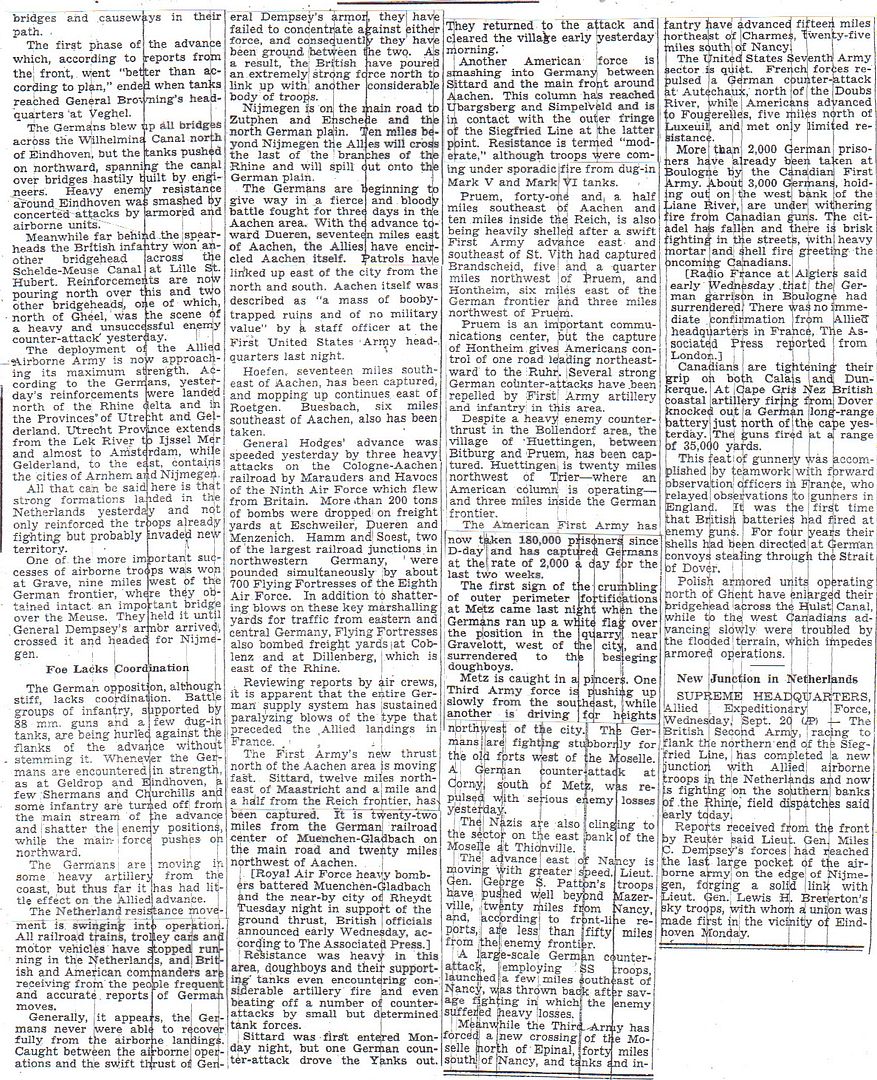
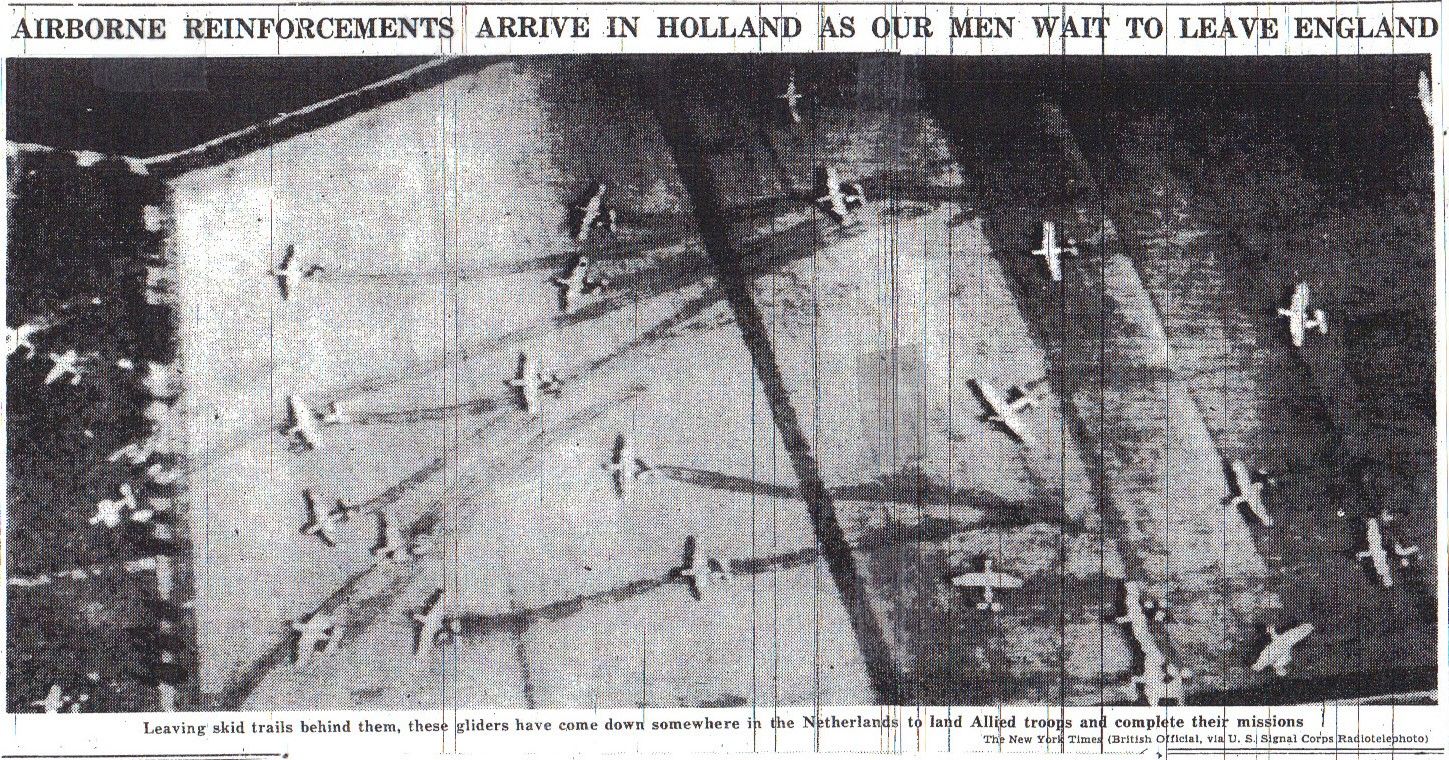
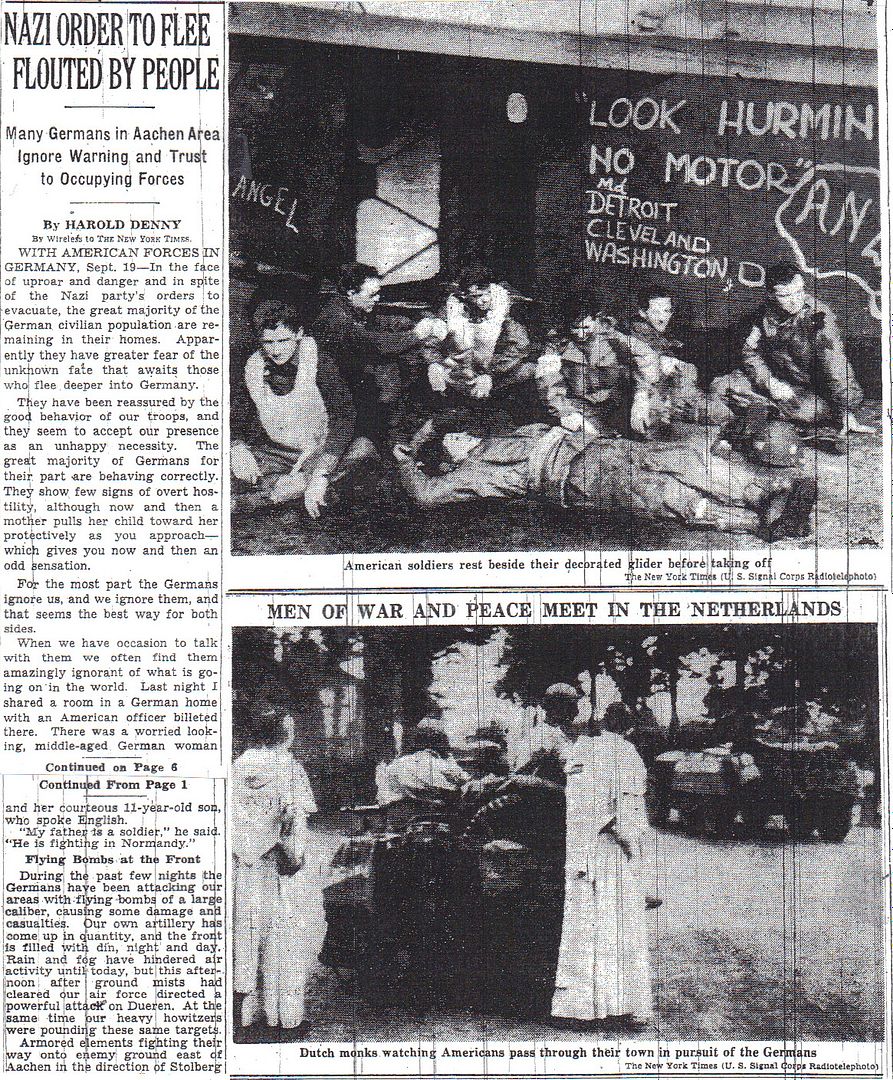
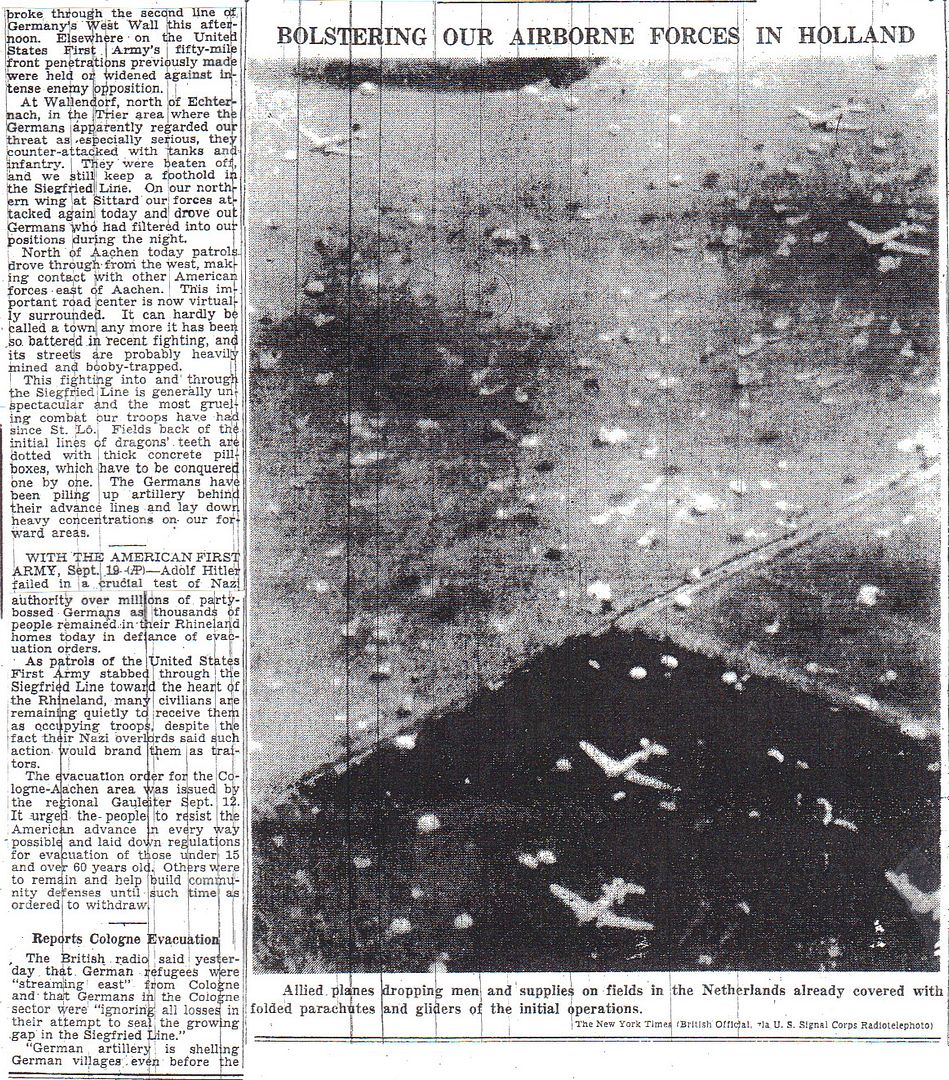
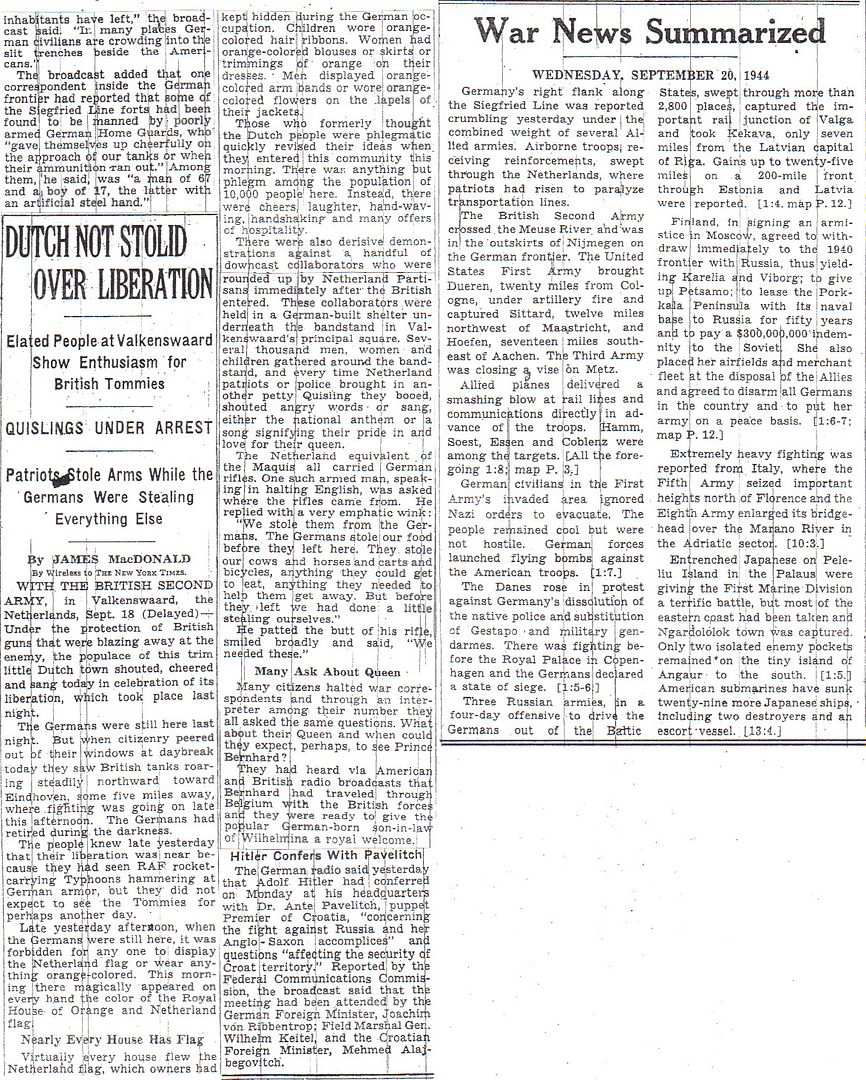

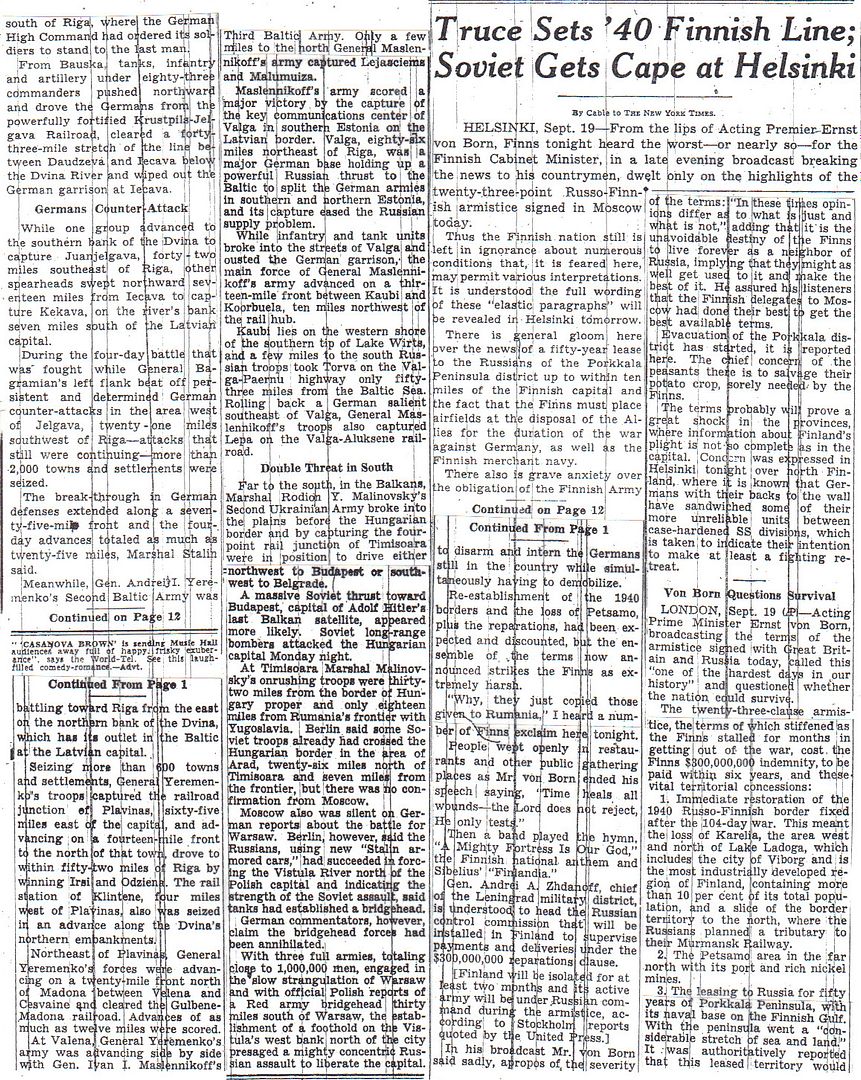
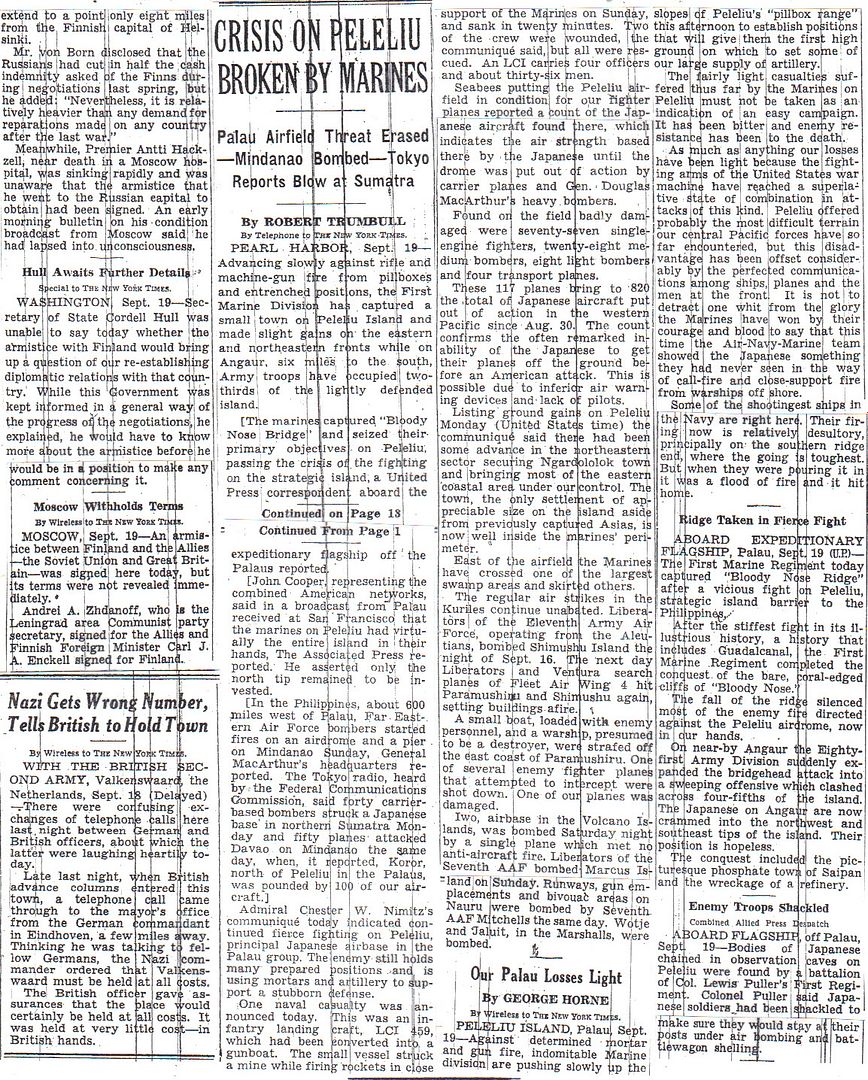
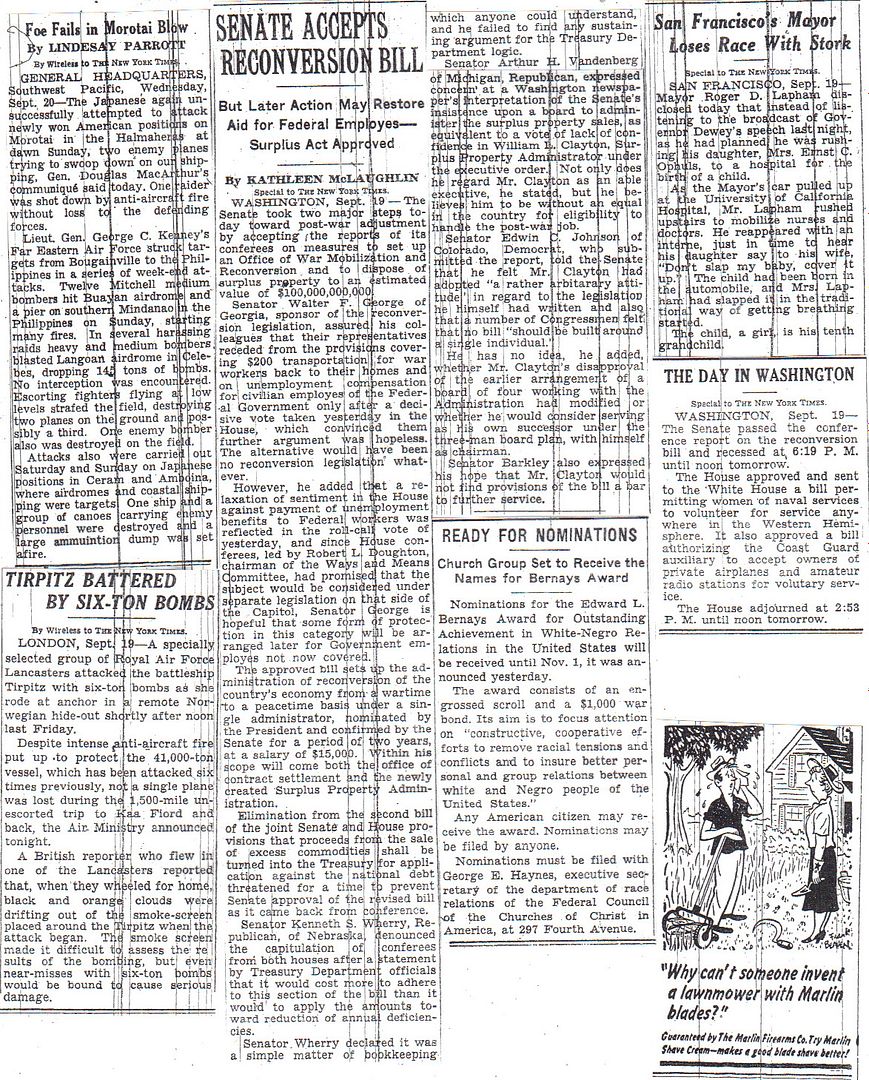

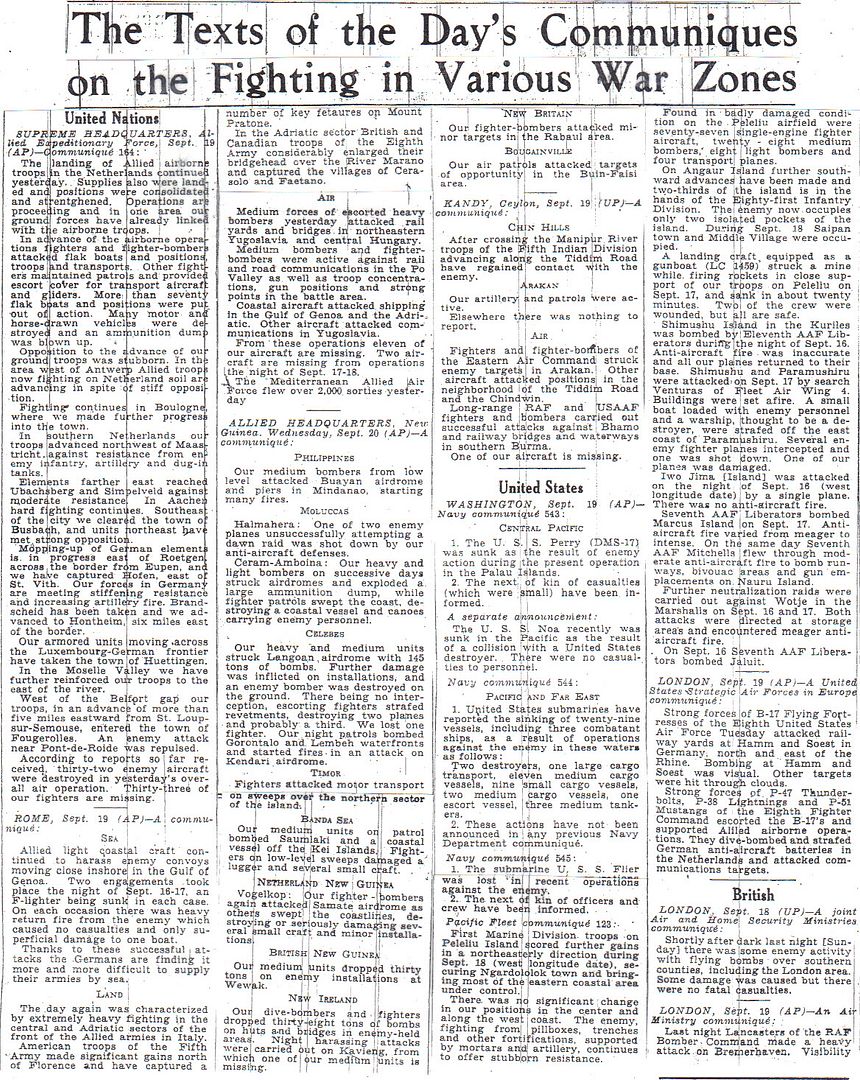
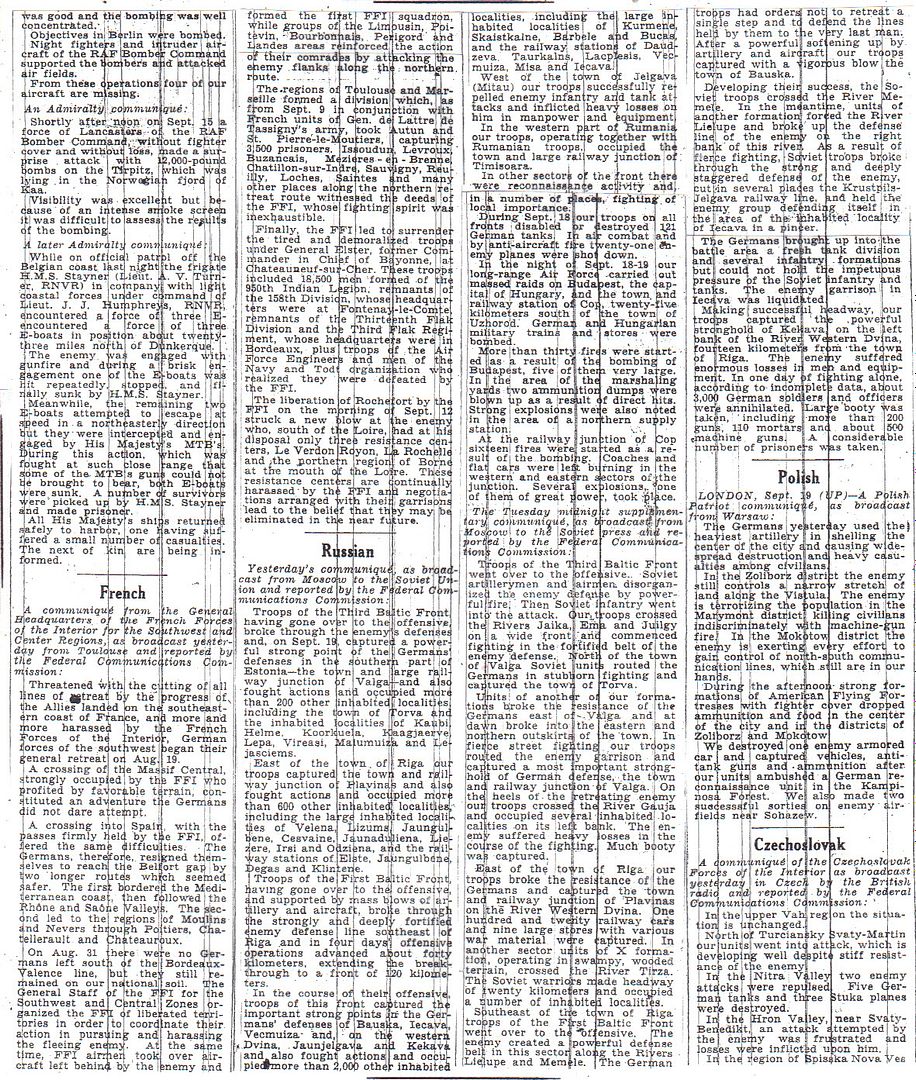
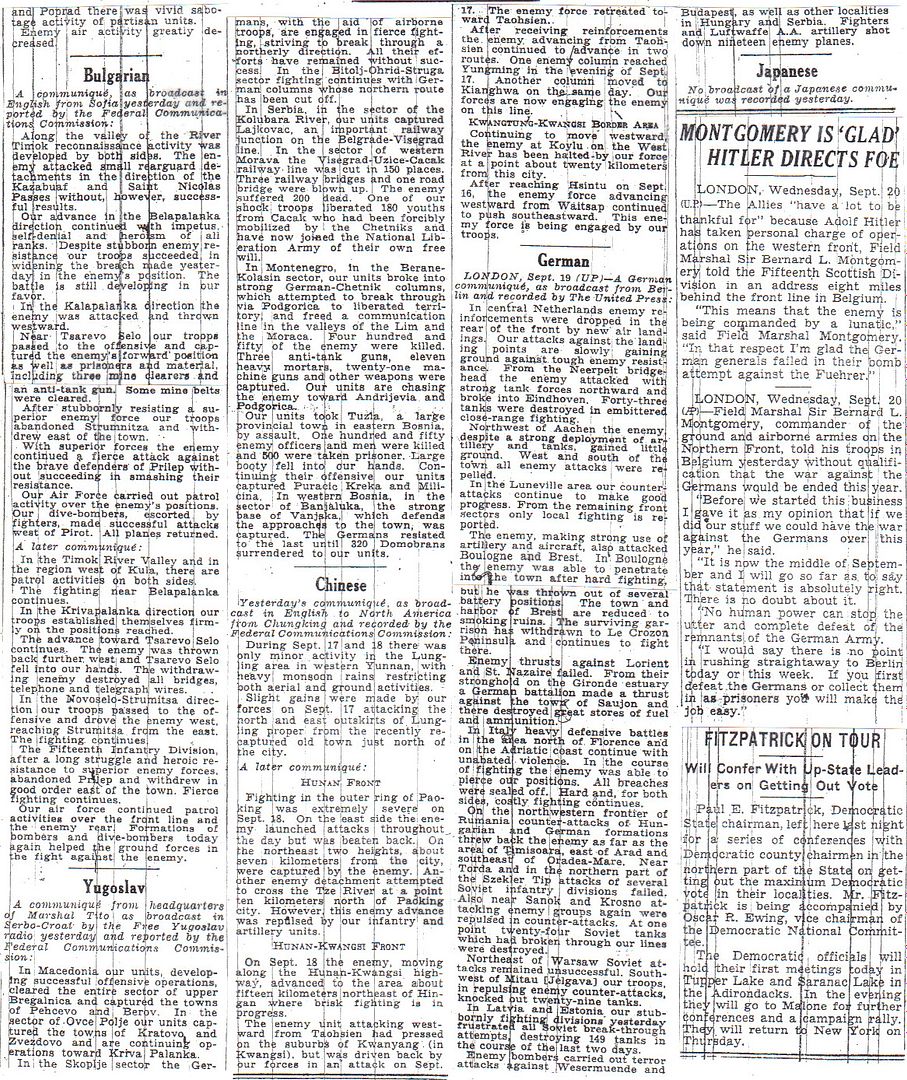
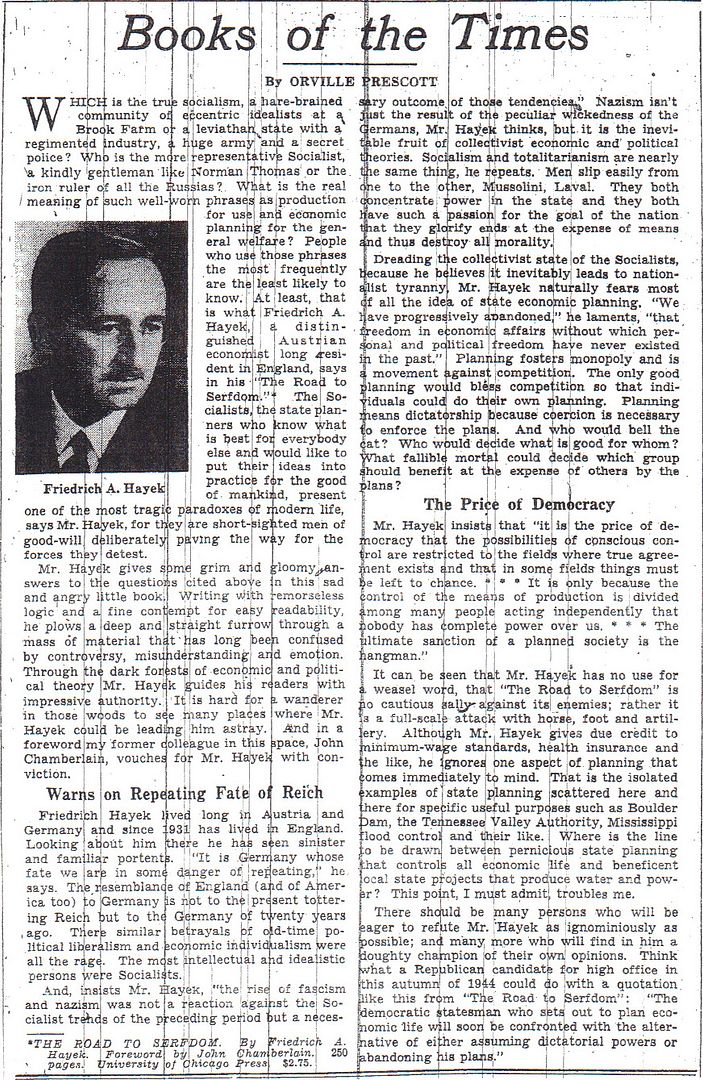
As supplies drop over Hartenstein (1:09)
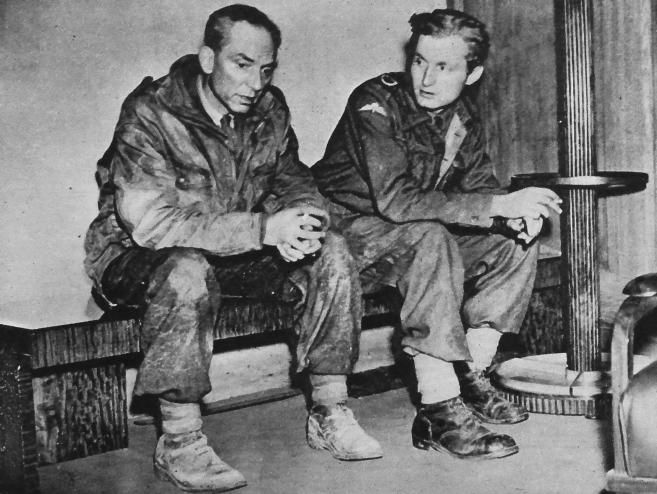
http://www.onwar.com/chrono/1944/sep44/20sep44.htm#
Germans secure bridge at Arnhem
Wednesday, September 20, 1944 www.onwar.com
The bridge at Arhem [photo at link]
On the Western Front... Operation Market Garden continues. A joint attack by the British Guards Armored Division and the US 82nd Airborne Division captures Nijmegen and the bridge over the Waal River. At Arnhem, the British 1st Airborne Division is forced away from the bridge by German forces. Meanwhile, Polish forces, part of Canadian 1st Army, make gains along the Scheldt River. Farther south, US 3rd Army (part of US 12th Army Group) captures Chatel and Luneville.
In Italy... The British 5th Corps (part of British 8th Army) enters the Republic of San Marino.
In Occupied Denmark... A general strike continues in protest of recent deportations by German authorities.
In the Palau Islands... On Angaur, most of the Japanese garrison has been eliminated by American forces. Some Japanese forces continue to resist in the northwest of the island.
http://www.etherit.co.uk/month/8/20.htm
September 20th, 1944 (WEDNESDAY)
NETHERLANDS: Arnhem: After four days and three sleepless nights, Allied paratroopers are holding out in spite of heavy shelling and repeated attacks by infantry and Panzers. But the British are fighting in scattered units, with radio links disrupted, by trees and tall buildings. Ground-to-air radio contact has also been disrupted and this has led to RAF resupply drops falling on zones still held by the enemy.
The command post in the Hartenstein Hotel is out of contact with the 150 men holding the northern end of the road bridge. All attacks across the bridge by German armoured cars and half-tracks have been repelled, but food, water and ammunition are running low.
In an operation dogged by misfortune, the British battle plan has fallen into German hands; it was found in a crashed glider. So when Brigadier John Hackett’s 4th Parachute Brigade arrived, the enemy was waiting and picked off the men as they hung helplessly beneath their parachutes.
The planned link-up with the beleaguered paratroopers has been mounted by the Guards Armoured Division, driving north from the Dutch border. Americans paras captured the Maas bridges, but were unable to gain the next crossing over the Waal, which is the south branch of the Lower Rhine, until the Guards arrived to link up at Nijmegen. A concerted drive from there towards Arnhem has since encountered strong Panzer resistance.
Market Garden: The U.S. 101st Airborne Division:
At 0615 German infantry and tanks attack the road leading from the south bank of the Wilhelmena Canal at Zon. The attack in beaten off by US Infantry and British Armour. It closes the road for several hours. The division CP displaces from Zon to St. Odenrode. 1/501 attacks west to seize Dinther and expand width of corridor. (Jay Stone)
The British Guards Armoured Division and U.S. 82nd Airborne Division:. The Grenadier Group with the 2/505 under command continues to attack through Nijmegan to seize the southern end of the railroad and road bridges across the Waal. 3/504 of the 82 Airborne is given the mission of crossing the Waal River in wood and canvas boats of XXX Corps Royal Engineers, seizing the northern bank and then securing the northern end of the road bridge. Support will be provided by RAF Typhoons, 30 tanks of the 2nd Battalion Irish Guards and 100 Field Artillery and mortar tubes. The river is 400 yards wide with flat areas of from 200 to 800 yards on the northern bank and a 15 to 20 foot dyke.
But first, the place chosen for the crossing needed to be cleared of enemy. This entailed clearing the German defenses dominated by the Valkhof which is a fort that had been selected by the Roman Second Legion as the key to Nijmegen and which now housed cleverly sited SS infantry and anti-tank defenses. This house-by-house clearing was done by infantry of the 1st Grenadier Guards and D Company 505 PIR with tanks in support commanded by Captain Neville.
Shortly after this battle started, II Falschirm Corps mounted a seven-battalion assault on 82nd Airborne positions, driving the Americans out of Wyler, Mook and Beek on the southeastern sector of the Allied stronghold. General Gavin appealed to the Coldstream Guards for tank support and got it. He became totally pre-occupied with events on that sector and learned of events of the river crossing assault only second hand.
H-Hour is set for 1500. At 1430, with the boats still en route, it is too late to reschedule the support of the Typhoons and they arrive overhead and fire rockets and machine guns at the northern bank. Ten minutes later the boats arrive and the men of 3/504 and the engineers begin assembling them. Each boat should have eight paddles, some have two. Of the 32 assault boats delivered, 6 are destroyed by artillery before being unloaded from the truck. The boats are assembled and carried over the open bank to the water. As the boats begin the crossing they are taken under fire by German machine guns and mortars. Of the remaining 26 boats that begin the assault carrying 3rd Battalion commanded by Major Julian A Cook, only 11 return to pick up the second wave. Combat Engineers of C Company, 307th US Airborne Engineer Battaloi, 82nd Airborne Division, ferry anti-tank guns across the river to protect the parachute infantry from armoured attack. The assault goes in at 1500 following a smoke bombardment which is lifted to fire HE at the German positions. Over 100 British and American guns fire this bombardment while two squadrons of Irish Guards tanks fire in support, shooting at anything and at any time, paying particular attention to the 20mm flak emplacements in the Fortress West. Mortars and artillery engage the Germans but this does not stop their fire which continues to fall on 3/504. As the first boats reach the shore the men attack toward the dyke and the bridge while the boats return for more soldiers. The engineers made five trips across the river in order to bring the 3/504 across. Initially the Germans on the northern end of the road bridge resist but with the pressure from 3/504 and the Grenadier Group from the south they break and run north from their positions and from the bridge. Many are cut down by American fire. By 1700 the northern end is secured and by 1900 British and Americans reach the southern end of the bridge. A platoon of No. 1 Squadron, 2nd Battalion Grenadier Guards crosses the bridge and links up with the Americans who have established a beachhead with a depth of 1/4 mile. The Guards move to Lent but are ordered to remain there because they have no infantry with them. For much of the night of 20/21 the only Germans between them and the south bank of the Lower Rhine are a few pickets. (Jay Stone)
In the two actions which secured the bridge the resistance of the Germans was fierce and Allied casualties were heavy especially within the 3/504 which lost half of the of the soldiers who made the river crossing. (Jay Stone)
Commentary: In the circumstances the decision by General Horrocks not to order the advance of the Guards Armoured was wise. The division was strung out over the road to the south and several of its units, particularly infantry, had been committed to assist the 82nd and 101st in their missions. Still, the 1st Airborne was dying at Arnhem and one has to ask what was the plan to relieve it after the bridge was crossed. The short answer is that there was no plan. General Adair, the commander of the Guards Armoured was surprised at the road over which his division would have to travel to Arnhem. This, despite the fact that there were aerial photographs of the position of the 1st Airborne at Arnhem available. Surely a photo reconnaissance mission of the road could have been flown at the time the Arnhem mission was flown. It should have been flown before Market Garden began. British soldiers had fought hard, died and accomplished much but their senior commanders had not done their homework. (Jay Stone)
1st Airborne Division: Attacks by German tanks and infantry continue against the position of 2 Para on the northern side of the Arnhem Bridge. Almost all of the buildings which it occupies are rubble and wounded fill the cellars. At 1000 hours communications between division headquarters and the elements of 1 Para Brigade headquarters at the bridge are establish. General Urquhart tells Colonel Frost that XXX Corps is expected to arrive within hours. He does not say how many hours. XXX Corps is still south of the Waal. Colonel Frost is wounded during the afternoon. In the evening a two hour truce is arranged and the Germans take the severely wounded from the cellars and make them prisoners. Colonel Frost remains with his battalion as do lightly wounded paras. The Germans take advantage of the truce to move into positions around the British positions. The situation for 2 Para is, indeed, grave. (Jay Stone)
The situation for the remainder of the division is also grave. Germans have established positions on three sides of the division which has its back to the river and holds a shallow horseshoe shaped beachhead centered on the division CP in the vicinity of Osteerbeek. (Jay Stone)
In the air, 679 USAAF Eighth Air Force P-38s, P-47s and P-51s are dispatched to support the First Allied Airborne Army in the Arnhem and Nijmegen areas of the Netherlands; 644 aircraft strafe and bomb ground targets; intense light flak claims 1 P-51 plus 1 P-38, 1 P-47 and 1 P-51 damaged beyond repair and 3 P-47s and 4 P-51s damaged; air attacks aid ground troops in taking valuable bridges in the area and in the advance toward Arnhem.
Arnhem: L/Sgt John Daniel Baskeyfield (b.1922), South Staffs Regt., was wounded but fired an anti-tank gun alone; he later crawled to another, scoring a direct hit before he was killed. (Victoria Cross)
Arnhem: Lt. John Hollington Grayburn (b.1918), Parachute Regt., inspired his men with his supreme courage, despite wounds from which he died. (Victoria Cross)
Wing-Commander Guy Gibson, awarded a Victoria Cross for leading the spectacular raid against three Ruhr dams last year, died when his Mosquito crashed near the village of Steenbergen. At his own request he had left a desk job to go on a raid against a German communications centre at Rheydt in the Ruhr. He acted as a pathfinder and master bomber for a Lancaster force. It is thought that his aircraft either developed engine trouble or was shot down by flak, and it seems that he was flying too low for him or his navigator, Sqn-Ldr J. B. Warwick DFC, to parachute out.
Gibson had seemed untouchable - the only survivor out of 25 aircrew who enlisted at the same time. He had narrow escapes flying Blenheims before Dunkirk. After the Battle of Britain he flew night fighters on 99 missions in two months, destroying six enemy planes. He also crash-landed between trees with a wounded crewman. As a bomber pilot he was on the first 1,000-plane raid against Cologne before the “Dambuster” epic; after leading the attack, he stayed to protect others. Aged 25, he won a DSO and DFC as well as his VC.
USAAF: STRATEGIC OPERATIONS: 679 US Eighth Air Force P-38s, P-47s and P-51s are dispatched to support the First Allied Airborne Army in the Arnhem and Nijmegen areas of the Netherlands; 644 aircraft strafe and bomb ground targets; intense light flak claims 1 P-51; air attacks aid ground troops in taking valuable bridges in the area and in the advance toward Arnhem.
In the Canadian First Army’s 2 Corps area, Polish armor overruns Hulst and Axel.
BELGIUM: In the Canadian First Army’s 2 Corps area, Polish armor overruns Hulst and Axel.
FRANCE: Cap Blanc-Nez, Normandy: 646 Allied bombers drop 5,600 high explosive bombs on two hours on the German guns.
During the day, RAF Bomber Command sent 646 aircraft, 437 Lancasters, 169 Halifaxes and 40 Mosquitos, to attack German positions around Calais; 633 bomb the target. Visibility is good and the bombing is accurate and concentrated. One Lancaster is lost.
In the U.S.. Third Army area, the boundary between XII and XV Corps is adjusted to give Foret de Vitrimont, Luneville, and Foret de Parroy to the XV Corps. In the XX Corps area, the 10th and 2d Regiments, 5th Infantry Division, renew efforts to take Pournoy-la-Chetive and Coin-sur-Seille despite weather conditions unfavorable for air support and diminishing supply of artillery ammunition; 2d Battalion of the 10th Infantry, reinforced, seizes Pournoy-la-Chetive but is greatly disorganized in the process; 1st Battalion of the 2d Infantry, against fire from Sillegny, overruns Coin-sur-Seille. CCA, 7th Armored Division, replaces badly mauled CCR in front of Sillegny and, together with CCB, attacks toward the Seille; bypassing Sillegny, CCA reaches the river, where it comes under heavy fire; CCB also reaches the river but falls back under fire. In XII Corps area, 80th Infantry Division elements push into Bois de la Rumont. The Germans counterattack 134th Infantry Regiment troops of 35th Infantry Division and recover Agincourt; the l37th Infantry Regiment attempts in vain to drive through Foret de Champenoux to Amance plateau but the artillery ammunition supply runs out. CCA, 4th Armored Division, begins an attack northeast toward Sarreguemines but, upon reaching Hampont on the left and the Dieuze area on the right, returns to the Arracourt region because of another enemy tank attack, this time by only 8 tanks, all of which are knocked out. The area will be systematically mopped up before the offensive is continued. Small tank duels occur as CCA sweeps through Ley and Moncourt. CCB continues efforts to advance in the Chateau-Salins area, where secondary routes are impassable. In XV Corps area, the 313th Infantry Regiment of the 79th Infantry Division drives through Luneville and turns southeast in an effort to outflank enemy’s Meurthe River line; the 34th reaches the Meurthe southeast of Luneville, where it comes under heavy fire. The French 2d Armored Division patrols from their current positions; CCL moves east to rejoin main body as the 45th Infantry Division of the Seventh Army draws up to the Moselle.
In U.S. Seventh Army’s VI Corps area, Lieutenant General Lucien K Truscott orders corps to cross the Moselle River and seize communications centers in the Vosges Mountains to open the way to the Alsatian Plain and the Rhine River. The 45th Infantry Division upon crossing the Moselle at Epinal, is to seize Rambervillers and Baccarat and force the Saverne Gap. The 36th Infantry Division is to cross the Moselle in the Eloyes area and take St Die near Saales Pass. The 3d Infantry Division is to cross the Moselle in the Rupt area and seizes Gerardmer near the Schlucht Pass. The 36th begins a reconnaissance in force of the proposed Moselle crossing site near Remiremont. The site near Eloyes is reported to be suitable, and the 141st Infantry Regiment moves forward to it during the night of 20-21 September. To the left, the 45th moves up to the Moselle in the Remiremont area. On the corps’ right flank, the 3d is advancing toward the river.
The French 1st Army now holds the sector to the right of the U.S. Seventh Army, the 2d Corps taking up positions in new sector to the left of the 1st Corps.
In the air, USAAF Ninth Air Force fighters provide air cover for the US XV and XX Corps in the Nancy area.
GERMANY: In The U.S. First Army’s XIX Corps area, the assault on the West Wall is postponed because of unfavorable flying conditions. Other deterring factors are the very short supply of arty ammunition and exposed left flank of corps. In the VII Corps area, the enemy decides to go on the defensive instead of counterattacking as planned. CCA, 3d Armored Division, is methodically clearing the Muensterbusch area; Task Force Hogan, is moving forward stealthily, and takes the enemy on Weissenberg Hill by surprise and gains the crest of this much fought over prize; Task Force Mills and CCB, secures positions on the Donnerberg River under a smoke screen but is hit hard by the enemy when smoke disappears. 1st Battalion of the 39th Infantry Regiment, 9th Infantry Division, attached to the 60th Infantry Regiment, drives east from Zweifall to Weisser Weh Creek, near the village of Huertgen. A battalion of the 6oth, to the right, attempts to drive southeast from Zweifall in order to cut the Lammersdorf-Huertgen highway at Germeter but makes little headway. In the V Corps area, IX Tactical Air Command again assists corps in maintaining positions.
In the air, about 40 USAAF Ninth Air Force B-26s hit the marshalling yard at Trier and defensive positions at Herbach to complicate rail transportation and aid in the Allied ground attack on Aachen; fighters fly air cover for the US V and VII Corps in western Germany near the Dutch boundary, and fly armed reconnaissance over the Bonn, Mannheim, Hamburg, Koblenz, and Ruhr Valley areas.
CZECHOSLOVAKIA: USAAF Fifteenth Air Force B-24 Liberators bomb three targets: 111 bomb Malacky Airfield, 28 bomb the Apollo oil refinery at Bratislava and 28 bomb a synthetic oil refinery at Bratislava.
MEDITERRANEAN
The British 8th Army enters the Republic of San Marino, in their drive up the Italian peninsula.
HUNGARY: USAAF Fifteenth Air Force B-17 Flying Fortresses and B-24s escorted by P-38s and P-51s bomb five targets: 117 bomb the marshalling yard at Hatvan; 56 bomb the railroad bridge at Szob; 56 bomb the South railroad bridge and 53 bomb the North railroad bridge both in Budapest; and 54 bomb the marshalling yard at Gyor. Two B-17s are lost.
During the night of 20/21 September, 58 RAF Liberators of No. 205 (Heavy Bomber) Group bomb the marshalling yard at Hegyeschalom; four aircraft are lost.
ITALY: In the British Eighth Army area, the battle for the Rimini Line ends as the Germans withdraw, during the night of 20-21 September, behind the Marecchia River under cover of a drenching rain. In the 5 Corps area, San Marino, in the small independent Republic of San Marino, falls to the Indian 4th Division. The 46th Division holds La Torraccia against counterattacks. The 1st Armoured Division joins the 56th Division in the fight for Ceriano ridge, where the enemy continues to resist tenaciously throughout the day before withdrawing. In the Canadian I Corps area, the Canadian 1st Division battles the encircled enemy at San Fortunato, frustrating German efforts to break out.
In the U.S. Fifth Army’s IV Corps area, Regimental Combat Team 6 of the Brazilian Expeditionary Force gains positions on Mount Prano but cannot reach the crest. The 1st Armored Division regroups in order to release CCA to the II Corps: the 37th Infantry Division, whose 1st Battalion relieves the 14th Armored Infantry Battalion, takes command of the CCA zone. The South African 6th Armoured Division extends its left flank to a road northeast of Pescia; reinforces the right flank in the Mt. Moscoso area. In the II Corps area, the 91st and 85th Infantry Divisions continue to pursue the enemy toward the Santerno River. 337th Infantry Regiment, 85th Infantry Division, crosses it east of Firenzuola at San Pellegrino. The 362d Infantry Regiment, 91st Infantry Division, gets into position for an assault on the Futa Pass, the 3d Battalion pushing across an anti-tank ditch near San Lucia. The Corps’ reserve division, the 88th, is ordered to attack through right flank of the 85th Infantry Division down the Santerno valley toward Imola on 21 September. In the British 13 Corps area, the enemy withdrawal from Casaglia Pass permits the 1st Division to push rapidly eastward toward the Indian 8th Division.
In the air, the USAAF’s XII Fighter Command, Twelfth Air Force, begins operations in support of the U.S. Fifth Army; weather again grounds medium bombers and severely restricts fighters which fly uneventful reconnaissance missions.
INDIA: The All-India Congress begins today in Bombay and continues until 23 September. Under the leadership of Mohandas K. Gandhi and Pandit Jawarharlal Nehru, they consider the British government’s offer of India autonomy. The delegates call the plan unsatisfactory and demand the British to “quit India.”
BURMA: US Tenth Air Force P-47 Thunderbolts hit the Kadu rail siding Nyaungbintha, Indaw, and troops at Hkaungtung; 3 B-25s weathered out of the Bhamo area hit alternates at Indaw; C-47 Skytrains continue large-scale operations to several points in the CBI.
CHINA: U.S. General Joseph Stilwell learns that his plan for the defense of Kweilin has been accepted by Chinese Generalissimo Chiang Kai-shek and issues orders accordingly.
27 US Fourteenth Air Force B-25s bomb Lingling, Chuanhsien, and Kiyang and hit targets of opportunity throughout the Chuanhsien area; 100+ P-51 Mustangs and P-40s on armed reconnaissance over wide areas of southeastern China attack troops, horses, trucks, shipping, and other targets of opportunity, particularly concentrating on areas around Chuanhsien, Lingling, Kiyang, Changsha, and Yiyang.
PALAU ISLANDS: On Peleliu, the firm Japanese defense of the central ridge system on western arm virtually halts forward movement of the 1st and 7th Marines. The 1st Marines is so depleted in strength that 7th Marines relieves all its troops but those along West Road. The 5th Marines is mopping up eastern arm.
On Angaur, Major General Paul J Mueller declares organized resistance at an end as the Army’s 321st Infantry Regiment drives to the southern end of island and begins mopping up scattered Japanese. The Japanese remaining on Angaur are concentrated in northwestern part of the island and are prepared for a prolonged defence of a broad, deep, bowl-shaped depression in the Lake Salome area. The 322d Infantry Regiment tries to reach the bowl from different directions, but makes little headway. Airdrome construction is begun in the southern part of the island.
WESTERN PACIFIC: USAAF Seventh Air Force B-25s pound Nauru Island.
MARIANA ISLANDS: USAAF Seventh Air Force P-47s from Saipan bomb and strafe gun positions on Pagan Island.
MARSHALL ISLANDS: USAAF Seventh Air Force B-24s bomb Jaluit Atoll.
NEW GUINEA: USAAF Far East Air Forces fighter-bombers hit AA guns and targets of opportunity at Moemi and Ransiki Airfields and hit a supply dump further east along the Orai River.
NETHERLANDS EAST INDIES: On Morotai, the beachhead perimeter has been expanded to provide space for additional airfield construction, extending about 1,000 yards (914 meters) north of the original site and some 10,000 yards (9.14 kilometres) east along the shore to the Sabatai River.
In the air, despite poor weather over Celebes Island, the USAAF’s Far East Air Forces attacks the Menado area and B-24s hit Mapanget and Sidate Airfields and supply dumps and other targets of opportunity. On Halmahera Island, B-24s hit Djailolo and A-20s and P-47s during the night of 19/20 September strike Kaoe Airfields. B-24s, B-25s, and fighter-bombers, striking during the night of 19/20 September and during the day, pound airfields at Amahai on Ceram Island, Namlea on Buru Island, Liang and Laha on Amboina Island, the town of Lautem on Timor Island, and several targets of opportunity. During the night of 20/21 September a few B-24s again hit the Menado and Sidate area on Celebes Island.
No. 14 RAAF Airfield Construction Squadron begins work on Wama airfield. (Mike Alexander)
NORTH PACIFIC: A lone Seventh Air Force B-24 on armed reconnaissance, bombs Marcus Island.
Interesting review of The Road to Surfdom.
Charlie don’t serf.
Enemy Troops Shackled
ABAORD FLAGSHIP, off Palau, Sept 19 - Bodies of Japanese chained in observation caves on the Peleliu were found by a battalion of Col Lewis Puller’s First Regiment. Colonel Puller said Japanese soldiers had been shackled to make sure they would stay at their posts under air bombing and battle wagon shelling.
Would seem Puller was liked by the enlisted men but not so much by junior officers. An account of Peleliu here:
http://www.historynet.com/peleliu
The German map has persistently shown paratroopers as far west as Tiel when none were ever there.
Today is Day 2 of the Battle of Arracourt which took place Sept 19-26, 1944. It is one of the largest tank engagements between the United States Army and the German Wehrmacht. Two Panzer Brigades and elements of two Panzer Divisions attacked one Combat Command of 4th Armored Division. The Americans were outnumbered and the Germans had plenty of new Panther tanks. The Americans were only equipped with short-barrelled Shermans, which everyone knows can't take on a Panther. Well, everyone except Bruce Clarke and Creighton Abrams. An excerpt of today's events from pp. 226-229 of The Official History of the United States Army in World War 2, "The Lorraine Campaign" by Hugh Cole.
************
On the morning of 20 September CCA began to move out toward the northeast, leaving one company of the 35th Tank Battalion near Arracourt to cover the concentration of the 320th Infantry (-), CCR, and the 602d Tank Destroyer Battalion, which were moving in to take over the area. (Map 5) To the north CCB, which had initiated the scheduled attack on the previous day, was fighting in a thick blanket of fog to clear a road through Château-Salins, after attempts to bypass on miserable side roads had bogged down. At 1130 the head of one column of CCA had reached Hampont and another was closing on Dieuze when General Wood radioed that enemy tanks had returned to the attack near Arracourt and that a task force must be sent back to the scene at once. Actually, only eight German tanks were involved, having made a sortie toward the 191st Field Artillery Battalion just as it was ready to limber up and join the march column. This attack was readily handled by the 155-mm. howitzers, firing high explosive at one thousand yards, and by the appearance of the rear guard tanks and some tank destroyers,which allowed none of the attackers to escape. But Colonel Clarke led his whole combat command to turn back and sweep up the entire area "once and for all."
Map 5
By midafternoon the sweeping operation was under way. Colonel Abrams assembled a force consisting of three medium tank companies of the 37th and two companies of the 10th Armored Infantry Battalion near Lezey, while the artillery adjusted its supporting fires, and then drove down on Ley. While Abrams had been gathering his people the Germans had moved to parry the coming blow by dispatching a Captain Junghannis and a group of Mark IV tanks and 88-mm. guns from the 111th Panzer Brigade reserve to positions on Hill 260 and Hill 241 west of Ommeray. The main American force went through Ley with hardly a shot fired. But C Company, 37th Tank Battalion, which was covering Colonel Abrams' flank east of Ley, ran head on into the fire of Junghannis' tanks and guns. Between Ley and Ommeray rise two low hills with a narrow valley between: Mannecourt on the west and Hill 241, slightly higher, on the east. Company C, coming over Mannecourt Hill, met a fusillade from the Germans on the forward slope of Hill 241. In a fight lasting about three minutes C Company lost five or six tanks-but inflicted about the same number of tank casualties on the enemy. Then the Americans drew back from the crest and waited for Colonel Abrams to come up with B Company. When Abrams arrived the two companies maneuvered into new positions and engaged in a brief tank duel which brought the losses for both sides to some eleven or twelve tanks apiece. Darkness was coming on and Colonel Abrams finally turned aside to complete the sweeping operation by a night attack southward, taking Moncourt and then bivouacking with his main body back at Lezey. On CCA's south flank Major Kimsey and a small force had been sent during the afternoon to mop up along the canal. West of Bures five Panthers on patrol were destroyed, but when Kimsey tried to move into Bures the German tanks, fighting from cover, outranged the M-4's and the Americans had to give up the attack.
Throughout the day CCA had held the initiative, but the additional armored weight given the LVIII Panzer Corps by the 111th Panzer Brigade prevented any clear-cut decision. General Blaskowitz, however, was far from satisfied by the events of 20 September and the Army Group G War Diary noted critically that "the Fifth Panzer Army shows a marked tendency to limit itself to defensive action." Again General Manteuffel was given a lecture on tactics and enjoined to regain his "operational freedom" by returning to the offensive and initiating counterattacks immediately after every American attack. Manteuffel's plea that the combat value of the two panzer brigades was "very limited" brought no reply from above. When Abrams took Moncourt, later in the evening, Manteuffel seized the opportunity to report that his lines had been broken at Ommeray, some two and a half miles farther east. He asked for permission to withdraw the LVIII Panzer Corps to a new and shorter line between Gélucourt and Lagarde, while redressing his southern flank, across the canal, by a general withdrawal in the XLVII Panzer Corps sector to a position east of the Forêt de Parroy and the Forêt de Mondon. Blaskowitz' only reply was a short homily on tactics and an order to counterattack.
I found them in the bushes. ;)
Seriously, you can find all of the daily situation maps for the western front online. They are the maps prepared by Col. Gen. Alfred Jodl for Hitler’s perusal at their daily conferences. On some of them, you can see the pencil marks made by one or the other showing new dispositions.
They can be downloaded here:
http://www.wwii-photos-maps.com/home_page_019.htm
I am excerpting these from the “Lage West” series. Each map is absolutely huge; probably 4’ x 5’. I have only cropped small parts for posting here.
I encourage you to donate to the gentleman who maintains this site.
Stanley looks a little like Frank Sinatra.
Wait a minute. I’m sure I should have noticed this before but THREE CENTS to buy a copy of the NYT? The federal government still had a ways to go to cause really serious inflation.
It’s worth a lot less than that today.
Disclaimer: Opinions posted on Free Republic are those of the individual posters and do not necessarily represent the opinion of Free Republic or its management. All materials posted herein are protected by copyright law and the exemption for fair use of copyrighted works.